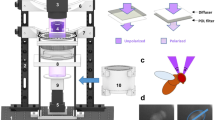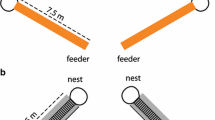Abstract
For spatial navigation many insects rely on compass information derived from the polarization pattern of the sky. We demonstrate that tethered flying desert locusts (Schistocerca gregaria) show e-vector-dependent yaw-torque responses to polarized light presented from above. A slowly rotating polarizer (5.3° s−1) induced periodic changes in yaw torque corresponding to the 180° periodicity of the stimulus. Control experiments with a rotating diffuser, a weak intensity pattern, and a stationary polarizer showed that the response is not induced by intensity gradients in the stimulus. Polarotaxis was abolished after painting the dorsal rim areas of the compound eyes black, but remained unchanged after painting the eyes except the dorsal rim areas. During rotation of the polarizer, two e-vectors (preferred and avoided e-vector) induced no turning responses: they were broadly distributed from 0 to 180° but, for a given animal, were perpendicular to each other. The data demonstrate polarization vision in the desert locust, as shown previously for bees, flies, crickets, and ants. Polarized light is perceived through the dorsal rim area of the compound eye, suggesting that polarization vision plays a role in compass navigation of the locust.





Similar content being viewed by others
References
Baker RR (1978) The evolutionary ecology of animal migration. Hodder and Stoughton, London
Baker PS, Gewecke M, Cooter RJ (1984) Flight orientation of swarming Locusta migratoria. Physiol Entomol 9:247–252
Brunner D, Labhart T (1987) Behavioural evidence for polarization vision in crickets. Physiol Entomol 12:1–10
Burghause FMHR (1979) Die strukturelle Spezialisierung des dorsalen Augenteils der Grillen (Orthoptera, Grylloidea). Zool Jahrb Physiol 83:502–525
Coulson KL (1988) Polarization and intensity of light in the atmosphere. Deepak, Hampton, VA
Draper J (1980) The direction of desert locust migration. J Animal Ecol 49:959–974
Eggers A, Gewecke M (1993) The dorsal rim area of the compound eye and polarization vision in the desert locust (Schistocerca gregaria). In: Wiese K, Gribakin FG, Popov AV, Renninger G (eds) Sensory systems of arthropods. Birkhäuser, Basel, pp 101–109
Eggers A, Weber T (1993) Behavioural evidence for polarization vision in locusts. In: Elsner N, Heisenberg M (eds) Gene-brain-behaviour. Thieme, Stuttgart, p 336
Farrow RA (1990) Flight and migration in acridoids. In: Chapman RF, Joern A (eds) Biology of grasshoppers. Wiley, New York, pp 227–314
Frisch K von (1949) Die Polarisation des Himmelslichtes als orientierender Faktor bei den Tänzen der Bienen. Experientia 5:142–148
Gewecke M (1975) The influence of the air-current sense organs on the flight behaviour of Locusta migratoria. J Comp Physiol 103:79–95
Homberg U, Paech A (2002) Ultrastructure and orientation of ommatidia in the dorsal rim area of the locust compound eye. Arthropod Struct Dev 30:271–280
Homberg U, Würden S (1997) Movement-sensitive, polarization-sensitive, and light-sensitive neurons of the medulla and accessory medulla of the locust, Schistocerca gregaria. J Comp Neurol 386:329–346
Homberg U, Hofer S, Pfeiffer K, Gebhardt S (2003) Organization and neural connections of the anterior optic tubercle in the brain of the locust, Schistocerca gregaria. J Comp Neurol 462:415–430
Kennedy JS (1945) Observations on the mass migration of desert locust hoppers. Trans R Entomol Soc Lond 95:247–262
Kennedy JS (1951) The migration of the desert locust (Schistocerca gregaria FORSK.). I. The behaviour of swarms. II. A theory of long-range migrations. Philos Trans R Soc Lond Ser B 235:163–290
Labhart T, Meyer EP (1999) Detectors for polarized skylight in insects: a survey of ommatidial specializations in the dorsal rim area of the compound eye. Microsc Res Tech 47:368–379
Labhart T, Meyer EP (2002) Neural mechanisms in insect navigation: polarization compass and odometer. Curr Opin Neurobiol 12:707–714
Mappes M, Homberg U (2003) Behavioral evidence of polarization vision in the locust Schistocerca gregaria. In: Elsner N, Zimmermann H (eds) The neurosciences from basic research to therapy. Thieme, Stuttgart, p 567
Mouritsen H, Frost BJ (2002) Virtual migration in tethered flying monarch butterflies reveals their orientation mechanisms. Proc Natl Acad Sci USA 99:10162–10166
Pfeiffer K, Homberg U (2003) Neurons of the anterior optic tubercle of the locust Schistocerca gregaria are sensitive to the plane of polarized light. In: Elsner N, Zimmermann H (eds) The neurosciences from basic research to therapy. Thieme, Stuttgart, p 567–568
Philipsborn A von, Labhart T (1990) A behavioural study of polarization vision in the fly, Musca domestica. J Comp Physiol A 167:737–743
Preiss R, Gewecke M (1991) Compensation of visually simulated wind drift in the swarming flight of the desert locust (Schistocerca gregaria). J Exp Biol 157:461–481
Riley JR, Reynolds DR (1986) Orientation at night by high-flying insects. In: Danthanarayana W (ed) Insect flight: dispersal and migration. Springer, Berlin Heidelberg New York, pp 71–87
Rossel S, Wehner R (1986) Polarization vision in bees. Nature 323:128–131
Uvarov BP (1977) Grasshoppers and locusts, vol 2. Centre of Overseas Pest Research, London
Vitzthum H, Müller M, Homberg U (2002) Neurons of the central complex of the locust Schistocerca gregaria are sensitive to polarized light. J Neurosci 22:1114–1125
Waterman TH (1981) Polarization sensitivity. In: Autrum H (ed) Handbook of sensory physiology, vol VII, part 6B. Springer, Berlin Heidelberg New York, pp 281–461
Wehner R (1982) Himmelsnavigation bei Insekten: Neurophysiologie und Verhalten. Neujahrsbl Naturforsch Ges Zürich 182:1–132
Wehner R (1984) Astronavigation in insects. Annu Rev Entomol 29:277–298
Wehner R, Michel B, Antonsen P (1996) Visual navigation in insects: coupling of egocentric and geocentric information. J Exp Biol 199:129–140
Acknowledgements
We are particularly grateful to Drs. Michael Gewecke und Reinhard Preiss for providing the wind tunnel and yaw-torque meter. Sincere thanks are given to Dr. Jan Dolzer for helpful and essential suggestions on data evaluation. This research was supported by DFG grants HO 950/13.
Author information
Authors and Affiliations
Corresponding author
Appendix
Appendix
Calculation of periodicity score P
The periodicity in the locusts yaw-torque response is quantified by the periodicity score P (for further details see von Philipsborn and Labhart 1990). It takes into account several parameters from the yaw torque histograms:
where a is the maximum number of positive yaw-torque responses (RGi) following each other in one string (A) of the histogram, b is the maximum number of negative yaw-torque responses following each other in one string (B) of the histogram, c is the number of sign alterations (+/−) in the histogram, m is the number of maxima in string A, n is the number of minima in string B, \( {\sum\limits_{}^A {RG_{i} } } \) the sum of positive RGi values in string A, \( {\sum\limits_{}^B {{\left| {RG_{i} } \right|}} } \) the overall sum of negative RGi values in string B, and \( {\sum\limits_{i = 1}^{36} {{\left| {RG_{i} } \right|}} } \) the overall sum of all 36 RGi values.
Rights and permissions
About this article
Cite this article
Mappes, M., Homberg, U. Behavioral analysis of polarization vision in tethered flying locusts. J Comp Physiol A 190, 61–68 (2004). https://doi.org/10.1007/s00359-003-0473-4
Received:
Accepted:
Published:
Issue Date:
DOI: https://doi.org/10.1007/s00359-003-0473-4




